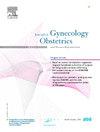Nine-step standard operating procedure for uterine preservation in placenta accreta spectrum: 7-year experience in a Chinese tertiary hospital
IF 1.6
4区 医学
Q3 OBSTETRICS & GYNECOLOGY
Journal of gynecology obstetrics and human reproduction
Pub Date : 2025-09-13
DOI:10.1016/j.jogoh.2025.103032
引用次数: 0
Abstract
Objective
To evaluate risk factors for adverse outcomes in the placenta accreta spectrum (PAS) and assess the efficacy of a nine-step uterus-sparing cesarean section protocol compared with traditional approaches.
Methods
This retrospective cohort study included 137 women with PAS who underwent cesarean delivery between 2016 and 2022. Participants were stratified into nine-step surgery (n = 26) and conventional surgery (n = 111) groups. The allocation of patients in each group was based on surgeon experience and surgical team’s intraoperative judgment. The protocol integrates placental mapping, transient uterine ischemia, delayed vascular control, and multilayer reconstruction. Machine learning (SMOTE-enhanced Random Forest) was used to identify the predictors of hemorrhage and hysterectomy.
Results
The nine-step surgery group reduced the hysterectomy rate to 1.9 % vs. 9.0 % in the control group (P < 0.001), with fewer severe complications (hemorrhagic shock: 3.8 % vs. 12.6 %; DIC: 1.9 % vs. 8.1 %). Multivariate logistic regression analysis confirmed that nine-step surgery was independently related to a lower probability of hysterectomy (P = 0.050) (odds ratio: 0.107, 95 %CI: 0.011, 0.998). Gravidity (Gini=3.809) and pathological placental adhesion (PPA) were key hemorrhage predictors. The hysterectomy prediction model achieved exceptional discrimination (AUC=0.993), driven by intraoperative blood loss (Gini=16.068) and PPA severity. Experienced teams preserved 83.3 % of the uterus, compared to 63.0 % in the less-experienced group (P = 0.008).
Conclusion
The nine-step uterine preservation protocol significantly reduced the hysterectomy rate in the PAS through dynamic risk stratification and staged hemostasis. Integrated machine learning models enhance precision management, enabling fertility preservation while minimizing the risk of severe complications.
九步标准操作程序在胎盘增生谱中保存子宫:中国三级医院7年的经验。
目的:评价累赘胎盘谱(PAS)不良结局的危险因素,评价九步保子宫剖宫产术与传统方法的疗效。方法:本回顾性队列研究纳入了2016年至2022年间接受剖宫产的137名PAS患者。参与者被分为九步手术组(n=26)和常规手术组(n=111)。每组患者的分配是基于外科医生的经验和手术团队的术中判断。该方案整合了胎盘定位、短暂性子宫缺血、延迟血管控制和多层重建。使用机器学习(smote增强随机森林)来识别出血和子宫切除术的预测因素。结果:九步手术组子宫切除率为1.9%,对照组为9.0% (p)。结论:九步子宫保留方案通过动态风险分层和分阶段止血,显著降低了PAS的子宫切除率。集成的机器学习模型提高了精确管理,使生育能力得以保留,同时最大限度地降低了严重并发症的风险。
本文章由计算机程序翻译,如有差异,请以英文原文为准。
求助全文
约1分钟内获得全文
求助全文
来源期刊

Journal of gynecology obstetrics and human reproduction
Medicine-Obstetrics and Gynecology
CiteScore
3.70
自引率
5.30%
发文量
210
审稿时长
31 days
期刊介绍:
Formerly known as Journal de Gynécologie Obstétrique et Biologie de la Reproduction, Journal of Gynecology Obstetrics and Human Reproduction is the official Academic publication of the French College of Obstetricians and Gynecologists (Collège National des Gynécologues et Obstétriciens Français / CNGOF).
J Gynecol Obstet Hum Reprod publishes monthly, in English, research papers and techniques in the fields of Gynecology, Obstetrics, Neonatology and Human Reproduction: (guest) editorials, original articles, reviews, updates, technical notes, case reports, letters to the editor and guidelines.
Original works include clinical or laboratory investigations and clinical or equipment reports. Reviews include narrative reviews, systematic reviews and meta-analyses.
 求助内容:
求助内容: 应助结果提醒方式:
应助结果提醒方式:


